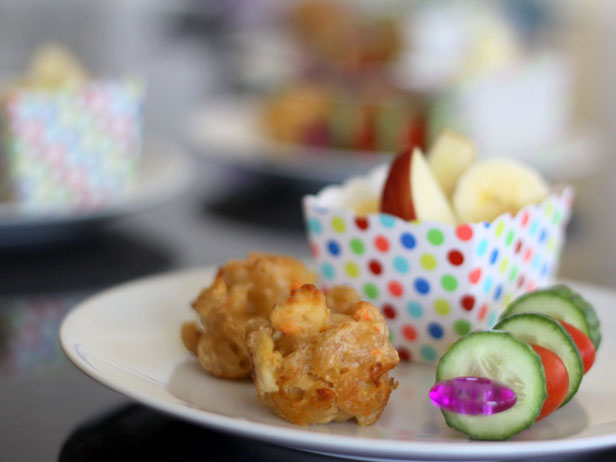How I Turn My Dinner Into a Week of "Mini Meals" for My Baby
With some easy adaptations (and a handy ice cube tray), I can cook once and feed my whole family. Here's how you can try it too.

Michelle Warner
Right now my husband and I are struggling to work from home while we chase around a curious 10-month-old baby. I'm trying keep things interesting and well- balanced for our meals, but of course there's never much time. However, working as a food stylist at Food Network means I've got quite a few culinary tricks up my sleeve — and lately, this one has been a life-saver for us: I'm relying on pantry staples plus a little fresh produce for dinners, and then spinning off the results into mini meals that our daughter can eat all week.
She gets to join us at the table, we save a little money and I like to think it helps her experience new textures and flavors. This isn't to say this replaces my other grab-and-go options: food pouches can be super helpful, but I hope that my strategy is helping to prevent her from becoming a picky eater down the road as she becomes more independent (though I know some pushback is inevitable!).
Here are some guidelines for how I go about this, and three recipes I have re-purposed to work for my husband and I, as well as the baby.
Rules of Thumb
- When making baby food, I look to find a balance of vegetables, grains, healthy fats and protein.
- I have found that a roasted vegetable in a little olive oil or sauteed with a little butter are better received than just boiled.
- I hold back on a lot of fruit and serve it only occasionally, because I want to keep her excited about savory foods and not dependent on the satisfaction of sweet ones.
- I only cook about 2 1/2 to 3 cups of anything for the baby; this lasts for multiple meals and it's easy for me to mix and match her portions.
- I give myself a break — not every meal will be perfectly balanced. I was getting caught up in trying to perfect early on. But just how like adults might occasionally eat a dinner of cheese and crackers, your baby's meals won't always be winners. And that's OK.
Storage
I store all of my daughter's food in 1-inch silicone ice cube trays because they make a perfect 1 ounce portion. I use the Tovolo brand because I know they are 100% silicon, and therefore baby-safe. Once frozen, I pop out the cubes and hold them in zipper bags. Then you can mix and match to make a well-rounded meal.
Reheating
I start by thawing the cubes for 1 minute at 70% power in the microwave, until they are softened. Then I stir them up and heat until warm in 10 – 15 second increments on full power. The portions are so small that it will only take 1 or 2 cycles to heat them.

How to adapt for baby:
- Add an extra 4-ounce salmon filet, but only brush it with olive oil and a light sprinkle of kosher salt
- Increase the amount of aspargus to 1 pound
- Increase the amount of bok choy to 1 pound
- Cook a little farro in chicken stock to go on the side — eat some, and save some for the next step.
- Use a food processor to blitz the extra veggies and 2/3 cup of cooked farro, then stir this mixture together with chunks of salmon. How much you process it (so, how mushy it gets) depends on how much texture your baby can handle.
- Portion the mixture out into a 1-inch cube ice tray.

Armando Rafael Moutela, 2014, Television Food Network, G.P. All Rights Reserved 2014, Cooking Channel, LLC All Rights Reserved
How to adapt for baby:
- Double the carrots, celery and beans (both you and the baby will appreciate this)
- Stir in about 5 ounces chopped kale, at the same time you add the beans
- Add a 28-ounce can of crushed tomatoes. These are great to always keep in your pantry, and you'll need more liquid to compensate for the increased beans and vegetables. The tomato will also slightly sweeten the soup, making it more appealing to baby.
- Reserve roughly 1/3 of the soup for baby and let it cool. Then pulse in your food processor to your desired texture.
- Portion the mixture out into a couple 1-inch cube ice trays.

Brian David Photography
How to adapt for baby:
- Use 4 1/2 pounds broccoli. Cut the florets into bite size pieces, and peel and chop the stems too. (In this recipe, you steam some of the broccoli and roast the rest for topping.)
- Double the spinach to 5 ounces.
- After you puree the soup, enjoy yours with about ⅓ cup of roasted broccoli per serving. Cut the rest in smaller bites for the portion you save for baby.
- Combine the remaining 1 quart of warm soup and the remaining roasted broccoli together and let it cool. The residual heat from the soup will soften the broccoli further to make it safe for baby to eat.
- Portion the mixture out into a 1-inch ice cube tray.
Related Links:























